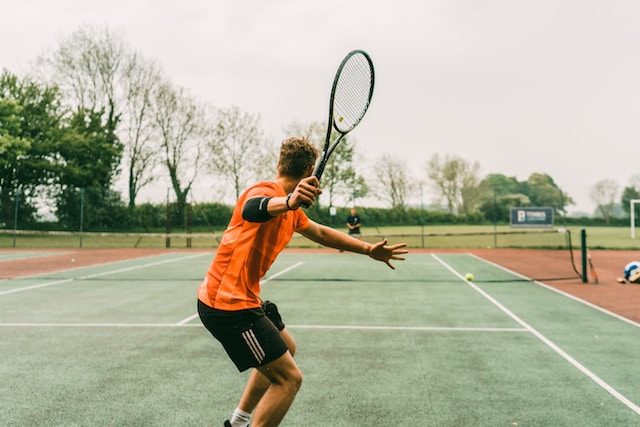To optimize your tennis fitness and performance, it’s important to follow a comprehensive routine that includes a warm-up, tennis-specific exercises, and a cool-down. Here’s a step-by-step guide to help you through each phase:
Warm-Up:
- Light Cardiovascular Exercise: Begin with 5-10 minutes of light aerobic activity to increase blood flow and warm up your muscles. Examples include jogging, brisk walking, or cycling.
- Dynamic Stretches: Perform dynamic stretches that mimic tennis movements and target major muscle groups. Include exercises like arm circles, leg swings, walking lunges with a torso twist, and high knees. Aim for 8-10 repetitions of each exercise.
- Tennis-Specific Movements: Incorporate specific tennis movements into your warm-up to prepare your body for the demands of the sport. Practice side shuffles, forward and backward movements, quick pivots, and footwork patterns.
- Mini-Tennis or Shadow Swings: Use a mini-tennis court or practice shadow swings to warm up your strokes. Focus on proper technique and gradually increase the intensity as you progress.
Tennis-Specific Exercises:
- Footwork and Agility Drills: Perform various agility ladder drills, cone drills, and mini-hurdle drills to improve your footwork, speed, and quickness on the court.
- Strength Training:
- Lower Body: Include exercises like squats, lunges, step-ups, and lateral movements to strengthen your legs and improve stability.
- Upper Body: Incorporate exercises such as push-ups, rows, shoulder presses, and rotational exercises to develop upper body strength and stability.
- Core: Engage in exercises like planks, Russian twists, medicine ball rotations, and anti-rotation exercises to strengthen your core muscles for improved stability and power.
- Cardiovascular Endurance:
- Interval Training: Incorporate high-intensity interval training (HIIT) into your routine. Alternate between periods of intense effort (e.g., sprints or fast-paced exercises) and active recovery periods (e.g., jogging or walking) to improve cardiovascular fitness and mimic the demands of tennis.
- Flexibility and Mobility:
- Static Stretches: After your workout or during cool-down, perform static stretches that target major muscle groups. Hold each stretch for 15-30 seconds without bouncing.
- Foam Rolling: Use a foam roller to release muscle tension and improve mobility. Focus on areas like the calves, thighs, glutes, and back.
Cool-Down:
- Gentle Cardiovascular Exercise: Finish your session with 5-10 minutes of light cardio, such as walking or slow jogging, to gradually decrease your heart rate and promote recovery.
- Static Stretches: Perform static stretches for the major muscle groups used during tennis, including the calves, quadriceps, hamstrings, hips, shoulders, and wrists. Hold each stretch for 15-30 seconds.
- Deep Breathing and Relaxation: Take a few moments to focus on deep breathing and relaxation to calm your mind and aid in recovery.
Remember to listen to your body and adjust the intensity and duration of exercises based on your fitness level and any pre-existing conditions. It’s also important to stay hydrated throughout your workout and replenish fluids afterward.
By following this comprehensive guide to tennis fitness, you’ll improve your strength, endurance, agility, and overall performance on the court. Stay consistent, practice regularly, and enjoy the benefits of a well-rounded tennis fitness routine!




